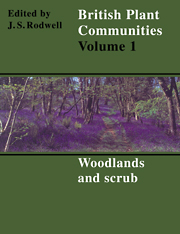Book contents
- Frontmatter
- Contents
- List of Figures
- Foreword
- Preface and Acknowledgements
- Preamble
- General Introduction
- Woodlands and Scrub
- Introduction to Woodlands and Scrub
- Key To Woodlands and Scrub
- Community Descriptions
- W1 Salix Cinerea-Galium Palustre woodland
- W2 Salix Cinerea-Betula Pubescens-Phragmites Australis Woodland
- W3 Salix Pentandra-Carex Rostrata Woodland
- W4 Betula Pubescens-Molinia Caerulea Woodland
- W5 Alnus Glutinosa-Carex Paniculata Woodland
- W6 Alnus Glutinosa-Urtica Jzozca Woodland
- W7 Ainus Glutinosa-Fraxinus Excelsior-Lysimachia Nemorum Woodland
- W8 Fraxinus Excelsior-Acer Campestre-Mercurialis Perennis Woodland
- W9 Fraxinus Excelsior-Sorbus Aucuparia-Mercurialis Perennis Woodland
- W10 Quereus Robur-Pteridium Aquilinum-Rubus Fruticosus Woodland
- W11 Quereus Petraea-Betula Pubescens-Oxalis Acetosella Woodland
- W12 Fagus Sylvatica-Mercurialis Perennis Woodland
- W13 Taxus Baccata Woodland
- W14 Fagus Sylvatica-Rubus Fruticosus Woodland
- W15 Fagus Sylvatica-Deschampsia Flexuosa Woodland
- W16 Quereus spp.-Betula spp.-Deschampsia Flexuosa Woodland
- W17 Quereus Petraea-Betula Pubescens-Dicranum Majus Woodland
- W18 Pinus Sylvestris-Hylocomium Splendens Woodland
- W19 Juniperus Communis Ssp. Communis-Oxalis Acetosella Woodland
- W20 Salix Lapponum-Luzula Sylvatica Scrub
- W21 Crataegus monogyna-Hedera helix scrub
- W22 Prunus Spinosa-Rubus Fruticosus Scrub
- W23 Ulex Europaeus-Rubus Fruticosus Scrub
- W24 Rubus Fruticosus-Holcus Lanatus Underscrub
- W25 Pteridium Aquilinum-Rubus Fruticosus Underscrub
- Index of Synonyms to Woodlands and Scrub
- Index of Species in Woodlands and Scrub
- Bibliography
W2 - Salix Cinerea-Betula Pubescens-Phragmites Australis Woodland
Published online by Cambridge University Press: 04 July 2020
- Frontmatter
- Contents
- List of Figures
- Foreword
- Preface and Acknowledgements
- Preamble
- General Introduction
- Woodlands and Scrub
- Introduction to Woodlands and Scrub
- Key To Woodlands and Scrub
- Community Descriptions
- W1 Salix Cinerea-Galium Palustre woodland
- W2 Salix Cinerea-Betula Pubescens-Phragmites Australis Woodland
- W3 Salix Pentandra-Carex Rostrata Woodland
- W4 Betula Pubescens-Molinia Caerulea Woodland
- W5 Alnus Glutinosa-Carex Paniculata Woodland
- W6 Alnus Glutinosa-Urtica Jzozca Woodland
- W7 Ainus Glutinosa-Fraxinus Excelsior-Lysimachia Nemorum Woodland
- W8 Fraxinus Excelsior-Acer Campestre-Mercurialis Perennis Woodland
- W9 Fraxinus Excelsior-Sorbus Aucuparia-Mercurialis Perennis Woodland
- W10 Quereus Robur-Pteridium Aquilinum-Rubus Fruticosus Woodland
- W11 Quereus Petraea-Betula Pubescens-Oxalis Acetosella Woodland
- W12 Fagus Sylvatica-Mercurialis Perennis Woodland
- W13 Taxus Baccata Woodland
- W14 Fagus Sylvatica-Rubus Fruticosus Woodland
- W15 Fagus Sylvatica-Deschampsia Flexuosa Woodland
- W16 Quereus spp.-Betula spp.-Deschampsia Flexuosa Woodland
- W17 Quereus Petraea-Betula Pubescens-Dicranum Majus Woodland
- W18 Pinus Sylvestris-Hylocomium Splendens Woodland
- W19 Juniperus Communis Ssp. Communis-Oxalis Acetosella Woodland
- W20 Salix Lapponum-Luzula Sylvatica Scrub
- W21 Crataegus monogyna-Hedera helix scrub
- W22 Prunus Spinosa-Rubus Fruticosus Scrub
- W23 Ulex Europaeus-Rubus Fruticosus Scrub
- W24 Rubus Fruticosus-Holcus Lanatus Underscrub
- W25 Pteridium Aquilinum-Rubus Fruticosus Underscrub
- Index of Synonyms to Woodlands and Scrub
- Index of Species in Woodlands and Scrub
- Bibliography
Summary
Synonymy
Fen carr Pallis 1911, Godwin & Turner 1933, Godwin 1936, Tansley 1939, Lambert 1951; Closed carr Pearsall 1918 p.p.; Rhamnetum, Franguletum, Rhamno-franguletum Godwin & Tansley 1929, Godwin 1936, 1943a, b; Betuletum Godwin & Turner 1933; Semiswamp and pseudo-swamp carrs Lambert 1951 p.p.; Calamagrostis sere Poore 1956bp.p.; Alder woodland type 2c McVean 1956bp.p.; Betulo-Dry opter ide turn cristatae Wheeler 1978; Osmundo-Alnetum (Klötzli 1970) Wheeler 1980c p.p.; Frangula alnus and Rhamnus catharticus sociations Wheeler 1980c p.p.; Betulo-Myricetum gale Wheeler 1980c p.p.; Alnus-Salix-Betula woodland Meres Report 1980 p.p.; Fen Woodland Fitter et al. 1980 p.p.
Constant species
Betula pubescens, Salix cinerea, Phragmites australis.
Rare species
Carex elongata, Dryopteris cristata, D. x uliginosa, Peucedanum palustre, Pyrola rotundifolia, Thelypteris palustris.
Physiognomy
The Salix cinerea-Betula pubescens-Phragmites australis woodland is rather variable in the floristics and physiognomy of its woody component. Salix cinerea and Betula pubescens are the most frequent species throughout and, together with some Alnus glutinosa, they usually form the bulk of the canopy. These major colonists show some differences in their preference for the various habitat conditions characteristic of the community (see below) but the chance availability of seed-parents and vagaries of propagule dispersal clearly play a large part in determining the composition and structure of the canopy, especially in the early stage of development (e.g. Godwin 1936). Moreover, these species show some ability to ‘leapfrog’ over one another in the colonisation process, so that, though S. cinerea is a common early invader (e.g. Pearsall 1918, Lambert 1946), it may be overtaken by waves of Alnus (e.g. Pigott & Wilson 1978) or B. pubescens. Without extensive detailed studies on a large number of sites, it is difficult to say whether there are consistent sequences of invasion which are reflected in the subsequent woodland structure. Young canopies of this community are certainly very heterogeneous internally and very different, one from another, comprising mixtures of these three species in various proportions, with individuals of different ages, forming a cover that varies from low, open scrub or very dense thickets to taller woodland with some stratification (e.g. Pallis 1911, Godwin & Turner 1933, Lambert 1951).
- Type
- Chapter
- Information
- British Plant Communities , pp. 52 - 64Publisher: Cambridge University PressPrint publication year: 1991



